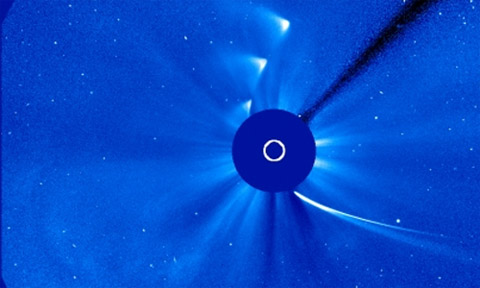“Reports are sketchy about its survival,” wrote Dr. Kenneth Hicks about Comet ISON’s close encounter with the sun. Hicks is Professor of Physics and Astronomy and wrote a Dec. 1 Columbus Dispatch article.
“Some early news reports say it didn’t survive the sun’s heat or its strong gravity field. Others on Friday indicated that part of its nucleus might have made it through.”

This NASA image shows Comet ISON moving toward the sun (bottom right) but only small pieces exiting (top left) after its encounter near the sun.
See the latest news from NASA on Comet ISON.
Either way, the scientific interest in this comet is not diminished. One reason astronomers are so interested in ISON is that its orbit indicates that it came from the so-called Oort cloud and is making its first encounter with the sun.
The Oort cloud sounds like a Klingon outpost, but actually it’s named for the Dutch astronomer Jan Oort, who proposed in 1950 that there is a vast array of small icy bodies that surround our solar system in the shape of a spherical shell.
These bodies are thought to have formed at the same time as the solar system and should contain information about the conditions present when Earth formed.
Comet ISON presents a unique chance to observe a 4.5-billion-year-old object as it goes from the coldest, farthest reaches of the solar system to the hottest, most severe conditions imaginable.
As the ice and frozen carbon dioxide evaporate from its surface, the comet’s underlying core becomes exposed, showing the range of elements that were present at the birth of the solar system….
While much is known about the composition of small asteroids, which regularly fall to the ground as meteorites and can then be studied in the lab, the composition of Oort cloud objects is largely unknown.



















Comments